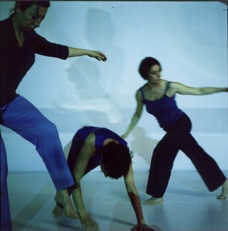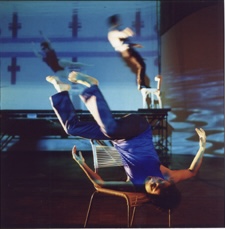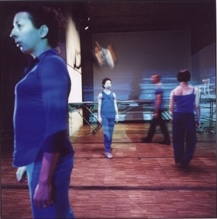Kitsou Dubois – Contact body — Object in Microgravity – 2004
Choreographer
First publication workshop Space: Science, Technology and the Arts in
collaboration with ESA/ESTEC, 2004
Images from the choreography Trajectoire Fluide Kitsou Dubois.
photos: Quentin Bertoux.
© Kitsou Dubois and Quentin Bertoux.



My artistic process is anchored around 3 points:
Experimentation, references to scientific and theoretical concepts and artistic retranscription through pieces combining various artistic approaches.
The goal is to take another look at the basis of movement and particularly that of danced movement, within the relationship of bodies, objects and environment in relation to experiments in weightlessness.
I will briefly explain the concepts on which I have based my artistic process through the project Trajectoire fluide (Fluid Trajectory) and I will present images of this piece, performed at the Grande Halle de la Villette in Paris, in December 2003.
I will then present the project Analogies, which is in the same vein as Trajectoire fluide but is based upon other researches and its feasibility is different – with regard to the partnership Arts and Sciences between the French National Center for Space Study (CNES) and the Parc de la Villette in Paris.
As far as the project Trajectoire Fluide is concerned, I have focused on the necessity to establish significant corporal bearings in this new zero gravity environment. The body is at the center of this experiment.
I have based my work on life sciences, with the perception in neurophysiology and more particularly with the notions of subjective vertical axis, boundaries of the body’s capability and bearings centred around themselves.
I have made a connection between these scientific theories and the danced movement. Once the artistic language was set up, we have, with my team, tried out gestures in weightlessness on board parabolic flights and in similar environments (in water and on the trampoline).
The aesthetic goal is to materialize theoretical concepts such as the establishment of a subjective vertical axis, the « in between » space, the bodies boundaries and swelling in order to provoke a sensitive interest in the audience.
I have found it therefore essential to use several artistic practices. With the large-scale imagery, movable objects, dance, circus arts and music, we have created trajectories between these different spaces where gravity is altered, in order to make them tangible for the audience.
Concerning the project Analogies, which will lead to the creation of a piece in the Parc de la Villette in November / December 2004, the process is the same. However, instead of dealing with this new time-space from the body, we are going to focus on the organisation of movements of weightless substance and connect them to the body organisation.
Therefore, thanks to an agreement, we have brought together, through our creation project, the CNES and the Parc de la Villette. This partnership enabled us to create a connection between scientific knowledge emerging from space activities conducted by the CNES and its artistic representation.
In the first place, a meeting took place in situ at three laboratories:
– The Institute of Fluid Mechanics in Toulouse: this Institute works, among others, on the diphasic exchanges between a gaseous state and a flow state. The observation of the behaviour of air pockets pulsated in a liquid medium is very different on earth and in microgravity. The narrow liquid wall, which persists on earth between air and water, becomes porous and the air pockets interpenetrate each other gradually.
– The French Atomic Energy Commission (CEA) in Pessac, Bordeaux: « The effect of vibrations in inhomogeneous matter: some studies in weightlessness ».
During vibrations, the absence of earth’s acceleration in weightlessness simplifies the various behaviour generated. Liquids, for instance, are only subjected to the mechanism of capillary force. The organisation of the elements among themselves is greatly altered.
– The Brain and Cognition Research Center, CNRS from the Medical Faculty of Toulouse works, among others, on visual illusions. We will focus here on the impact force of a visual reference which can work like a support point in weightlessness and substitute for gravity. This is interesting both gestually and for guiding the spectator’s eye.
In the second place, we appropriate the scientific concepts during workshops, called experimental laboratories:
I mainly focus on contact points and on support spaces. I as well turn my attention on deconstruction and restructuring phenomena in microgravity which will have an effect on a bodies’substance and group organisation.
Seven experimental laboratories are set up:
– Two parabolic flight laboratories. One flight already took place in April 2004 for test purposes and another one will take place in autumn with six performers of the company.
– Two laboraties will be centred around the theme « dance and circus » where acrobatics, trapeze and chinese pole will be associated to the dance abstraction. Vibrations, sounds and music will accompany these laboratories.
– Two laboratories in liquid environment (swimming pool).
– One laboratory centred on contact where light and shade will be materialized
The work resulting from these laboratories is filmed. Afterwards, imagery is reworked in order to create a link between the substance movement and the body movement. It will be given a place and integrated with the set design.
These laboratories will give rise to a language, a body dynamic and to data process of aesthetic choices.
All these elements will be the subjects of the piece Analogies, which will be performed at La Maison de la Villette in Paris between November 24th and December 19th 2004.
The creative process Arts and Sciences will be recreated in a filmed documentary, presented at the end of the piece.
Bibliography:
– K. Dubois, thesis in The Application of Dance Techniques to Weightless Flight: Weightless Dancer at the Art Aesthetics, Sciences and Technologies department of the Université de Paris VIII, 1999.
– K. Dubois, C. Tafforin, Elaboration of a sensorial and gestural training in microgravity, from dance technics, on earth, on water and on a tilted plane, VI° jounées internationales d’automne de l’ACAPS, Guadeloupe, 1995.
– K. Dubois, Dance and Weightlesness: dancer’s training and adaptation problems in microgravity, Leonardo, MIT Press, Berkeley USA, 1994.
– K. Dubois, T. Poxxo, A. Berthoz, Effect of training on postural strategies during complex equilibrium tasks in the frontal plane, 1993, presented at the « International Society of Biomechanics, XIVth Congress, Paris.
© Kitsou DUBOIS & Leonardo/Olats, mai 2004 / republished 2023
Leonardo/Olats
Observatoire Leonardo des Arts et des Techno-Sciences
À propos / About | Lettre d'information Olats News



Pour toute (re)publication, merci de contacter / For any (re)publication, please contact Annick Bureaud: info@olats.org
Pour toute question concernant le site, merci de contacter / For any issue about the website, please contact: webmaster@olats.org
Design Thierry Fournier
© Association Leonardo 1997-2022